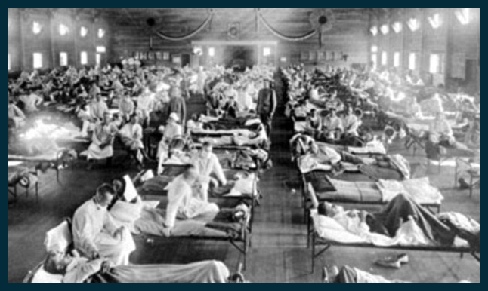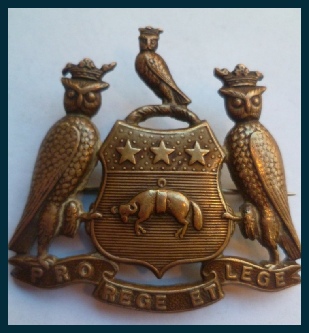Copyright © All rights reserved.



George Wallace Piercy
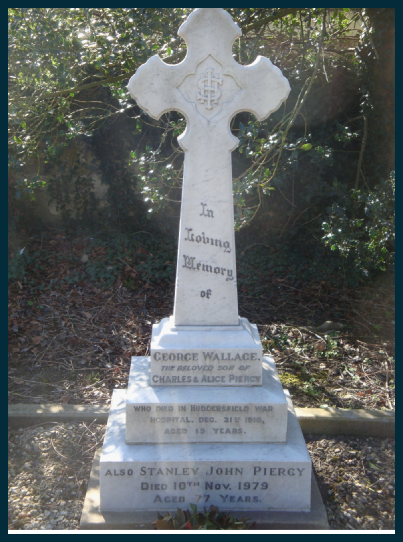
By 1901 they were living in Finkle Street close to the Market Square and the first of their children, Wallace had been born.
1901 Census - 13, Finkle Street, Malton, Yorkshire
Charles Piercy, Head, Married, Male, 30, Bridlington, Yorkshire, Joiner
Alice Piercy, Wife, Married, Female, 28, Crook, Durham
George Wallace Piercy, Son, Single, Male, 1, Malton, Yorkshire
Wallace attended Malton Grammar School and was also a pupil teacher at the Wesleyan Day School, taking an active interest in the Wesleyan church.
1911 Census – 13 Finkle Street, Malton, Yorkshire
Charles Piercy, head, married, male, 40, House joiner, worker, Bridlington, Yorkshire
Alice Piercy, wife, married 14 years, female, 3 children born and living, 38, -
Wallace Piercy, son, male, 11, school, -
Stanley Piercy, son, male, 8, school, -
Clarice Piercy, daughter, female, 5, school, -
George Wallace Piercy was born on 17 April 1899 in Malton,the eldest son of Charles and Alice (nee Thistlethwaite) Piercy who married in Scarborough in the first quarter of 1897 Charles came from Bridlington but by the time he was 10 years old his parents had moved to Norton and by 1891 he was working as a wheelwright. Alice was the daughter of a shoemaker in Crook, County Durham and by 1891 she was an apprentice milliner in Charles Thompson’s draper’s shop in Wheelgate.
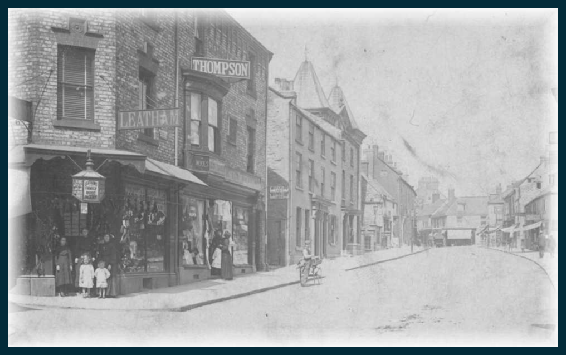
War broke out and presumably Wallace did not enter the army until he was eighteen and his army number would suggest that he probably joined up in May 1917 in Malton and after training in the reserve battalions would have been posted to “A” Company of the 15th (1st Leeds) battalion of the West Yorkshire regiment in Spring 1918. Otherwise known as the Leeds Pals, this battalion only recruited from non-
In March 1918 the battalion spent the first half of the month in reserve engaged in acquitting themselves well in a variety of sporting competitions but on 22nd March they arrived in the Bullecourt sector to take over that area of the front line. For the next few days they had an extremely torrid time as they came under intense shellfire resulting in some 20 dead, 90 missing and about 500 missing.
At the end of March they returned to the reserve and a further flurry of sport and training until they were ordered back into the front line reaching the line at Borre on the 11th April and retreating to Hondeghem on the evening of the 12th. From here they retreated to the railway line which they managed to hold under extremely heavy machinegun fire for a while before “A” company covered further retreats to a position behind the lines held by the 33rd Division. The War Diary records heavy losses during these few days – 26 killed, 160 wounded and 145 missing. Among the missing was Wallace.
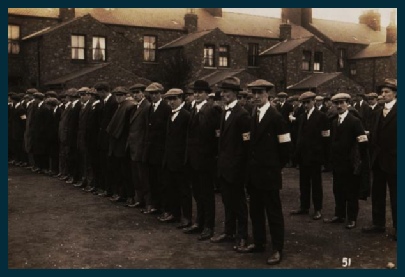
He was not wounded but was taken prisoner on 12/4/18 and was sent to Gardelegen POW camp.
Gardelengen does not seem to have been a bad place by general standards – a Red Cross report of 1915 states that it housed “6,662 French, Russians, English, Belgians and few civilians from most of the occupied departments in the north of France. The commander, Colonel Grüner, is a man of heart and feeling, who does not consider the prisoner as an enemy, but as a man worthy of pity.
The barracks are new, the tarred canvas roofs; the walls painted white, high and clear, make a pleasant impression. The kitchens, in sufficient number, are installed practically: real kitchens of troops. Latrines smell clean, disinfected regularly; and since there is no pipeline, they are emptied by means of closed tanks. The bath and shower facilities are numerous. A new building is being built for washing linen and drying it. The barracks are kept clean. The beds consist of a straw bag or a bag of wood wool, a pillow and two blankets of wool. The Lazaret installations are very satisfactory; good medical treatment, in which also a French doctor participates. Prisoners can write a letter or three cards every ten days. At Christmas and the New Year, a huge mass of letters and packages arrived. When they are up to date, they can write every 8 days. When the warrants arrive payment is made in the sum of 20 to 23 Mk against receipt. Larger payments are not made to avoid money theft and corruption. No complaints were received about non-
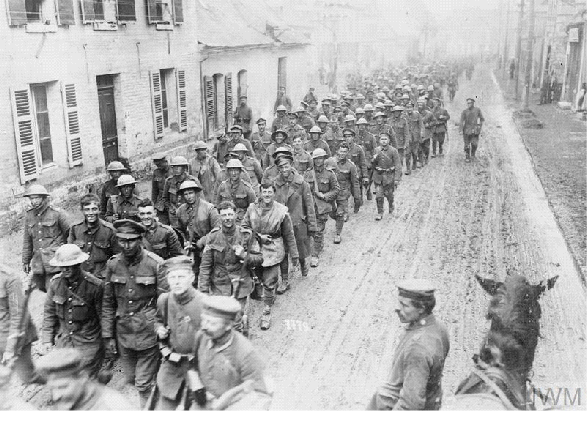
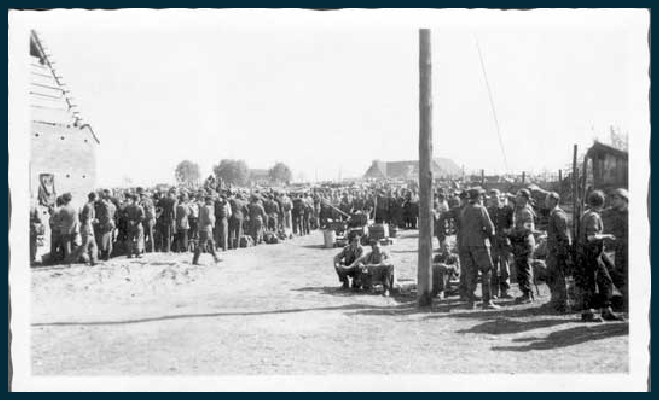
The interrogation of the prisoners gave only satisfactory answers. I would like to point out here once and for all that "satisfactory answer" does not mean naturally that people are willingly prisoners, but only that they are happy, ignoring the limitation of their freedom, which, of course, is felt as an imposition. As for work, there is not much to do in this camp. There is some reading. Men are currently working on the publication of a French newspaper.
The appearance of the prisoners is good. The following weekly menu provides food information:
Per day: 500 gr. of bread. Every morning, coffee.
Sunday -
Monday -
Tuesday -
Wednesday -
Thursday -
Friday -
Saturday -
Nonetheless it must have been a traumatic experience for Wallace.
Prisoners of war were transported in box cars, the floor of which was covered with straw; necessary stops were made from time to time for food, etc. Prisoners who were severely wounded or those who might need medical or surgical care were transported in ambulance trains. Officer prisoners of war were as a rule given transportation in passenger coaches of third or even second class.
When a prisoner of war arrived at a camp, which had been selected by the military authorities, he was isolated for a period of three weeks in a separate company compound. Intercourse with the other prisoners was not permitted and only those German officers who were assigned to this special duty were permitted in this camp area. Inasmuch as these prisoners were recently taken, sufficient time had not elapsed for food packages to arrive from home and they were compelled to subsist on the German camp food which added to their other trials was a distinct hardship.
During this period of detention a careful physical survey was made. Prisoners were vaccinated against typhoid, smallpox and cholera and underwent a personal disinfection. All his clothing and personal equipment were fumigated or sterilized. After the period of detention the prisoners were distributed to the various companies in the camp.
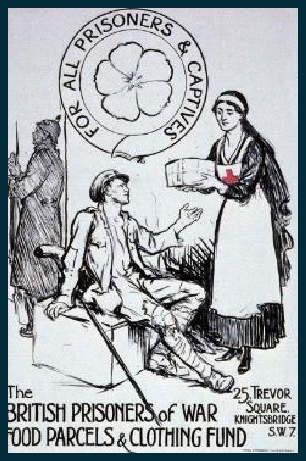
The barracks were as a rule heated by stoves and during the winter months some of the camps allowed the prisoners to cook their food packages on these. Most barracks had electric light. In each camp division there was a long concrete or wooden wash tub for washing and laundry.
There was also a disinfecting establishment in a separate barrack building where the prisoners had to take off their clothes which were then tagged and put into a large, dry-
Kitchens were in a separate building, as a rule, and were equipped with a series of large kettles in which the food was prepared in the form of soup. One of the barracks was usually given over to a combination of religious services and for a theatre. A part of the camp enclosure was kept free for drills and athletic exercises. Here at stated periods of the day the men could play football or indulge in field sports. A small room in one of the barracks was usually assigned for use as a library.
However unpleasant he may have found Gardelegen, Wallace was not here for very long. By 13th September he was transferred to Minden in Westphalia characterised by Daniel McCarthy who inspected German PoW camps on behalf of the American Government in 1918, “The camp at Minden could, on the other hand, be used as a model of what a camp for prisoners of war ought not to be.
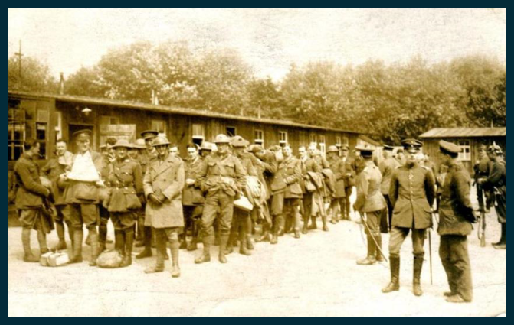
The camps usually held from ten to twelve thousand prisoners and were usually located along the lines of railway communications n country districts. They consisted of long rows of low buildings built of wood, extending in the larger camps, for two or three miles. One or more watch towers, on the platforms of which heavy guns are mounted, rose above the camp which was surrounded by two rows of barbed wire approximately twenty feet apart and sometimes this was further surrounded by a board fence twelve to fifteen feet high.
Camps were divided into blocks and these again into smaller areas. A camp of ten thousand men would be divided up into five blocks separated from each other by barbed wire partitions, each block housing a battalion of two thousand prisoners, sub-
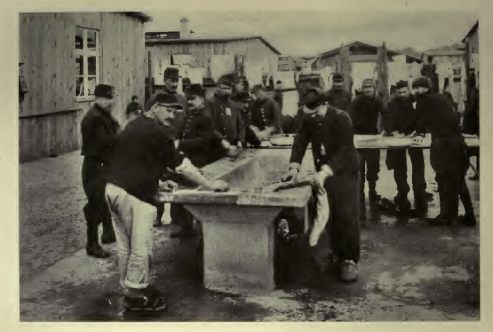
There are in the camp 8,682 prisoners of war, of whom 615 are British, and of the British, 357 are non-
The camp is arranged in a block system, with the barracks of each block arranged in such a way as to form a square with an open area in the court of about one hundred metres square. There are five blocks. As arranged at the present time each block is completely separated from the other blocks. The prisoners of war in each block are absolutely limited to this block area, are not permitted outside of it, and as the barracks, except for the small gateway, completely enclose this area, there is no opportunity to see anything other than the four barrack brick walls and the open sky above. There are no trees or shade in this area, and …the surface area is of hard yellow clay without any grass or other evidence of vegetation. In the space in this court, which is not taken up with the kitchen, latrines, etc., the men play football.
The British are housed in the long barracks forming the walls of the square… The British complained that the roof leaked during the month that they had been interned there. An inspection of the roof showed places where the men had packed boxes against the roof over their beds to keep out the leaking water.
The beds are of the double tier, built-
The punishment barrack was visited. It is an empty barrack room in Block 3, which contains no other prisoners at the present time. Five British were confined here. Two of these were confined for refusing to work. The other three men, Privates W, Q , and J , stated that they did not know why they were being punished, and had done nothing to warrant their confinement except to report sick. One of these claimed that his case had been diagnosed in the hospital as chronic tuberculosis of the lungs, and that he now has the symptoms of that disease. (It is tempting to speculate that “Private W.” was none other than Wallace Piercy who would by this time undoubtedly have been showing symptoms of T.B.) This barrack has a barbed wire barrier in front of the door. A sentry is stationed in the barrack, and the men are not supplied with blankets or mattresses, but must sleep on the bare floor in their clothes. They are not permitted to have their packages, and must subsist on the camp food. They are not permitted a change of clothes. Notwithstanding the above, the commandant stated that these men were not under arrest and when a statement was requested as to why the above three men did not know why they were confined there, no one seemed able to explain the matter or to give us any information concerning it.
Complaints were made in both Blocks I and V that police dogs were brought into the barrack rooms at night and cleared the barracks so that men had to be in bed before the dogs were brought in. The dogs were kept in the square at night. The men stated that the dogs were set loose in the barrack rooms. Sergeant W. H was attacked by one of these dogs in the night of July 2nd, as he crossed this square returning to his barrack from the latrine. The commandant made the statement that this case had been reported to him by the guard, who reported that the dog had broken the leash and had attacked the prisoner of war… The commandant stated that attempts at escape by tunnelling were so frequent that the dogs were trained to detect men in this act.
The lazarette (hospital) of this camp is situated outside the camp and is composed of six wooden camp barracks, each divided into two rooms by a partition at the end of each barrack. The beds were arranged in most of the barracks in double rows, filled for the most part with badly wounded men, transported almost directly from the battle line to this hospital. In other words this temporary, crudely constructed camp lazarette intended for the incidental case of illness of prisoners of war, and without the equipment in the nature of operating rooms, dressing rooms, special apparatus, nursing staff, etc., was, practically without any preliminary notice, transformed into a first base hospital.
A large number of the men are severely wounded…with insufficient nursing attention and inadequately fed. The nursing is done by hospital orderlies. There are no women trained nurses in the place. An English noncommissioned officer is present in the hospital as interpreter. The senior noncommissioned officers at the camp requested permission to be assigned to the camp to help. This was refused. Sergeant M , a lay reader of the Church of England, interned in Block V, had requested permission to visit the sick and dying prisoners in order to give them religious consolation, or to help in the hospital. This was refused.
In a letter accompanying this report it is stated in contrasting this camp with the one at Dulmen and Friedrichsfeld that: "The camp at Minden could, on the other hand, be used as a model of what a camp for prisoners of war ought not to be. It is built in a relatively unhealthy location, of poor general plan, and as administered, is more of an actual prison for the men, more particularly the non-
To add to all of this the pitiable spectacle of the hospital attached to this camp was almost too much for a human being to stand. To have placed such a large number of such seriously wounded men jammed together in such crude barracks with insufficient medical attention, no nursing worthy of the name, and with such food as normal men could not eat, was a blunder, and a blot on German science. What possible excuse to send men to such barracks and to such a camp, could be offered, I cannot well imagine. When to the sight of men sick and suffering and dying in the throes of lockjaw, with a dirty towel between the teeth, men dying prisoners in a foreign land without a gentle voice or sympathetic hand to ease their suffering, there was added the brutal, blind obedience to regulation, that would withhold religious consolation when it was at hand and anxious to help, this indeed surpasses all human understanding…I do not see how any man with human instincts could permit a single day to pass with such conditions existing and for which he was responsible, without attempting to remedy them.”
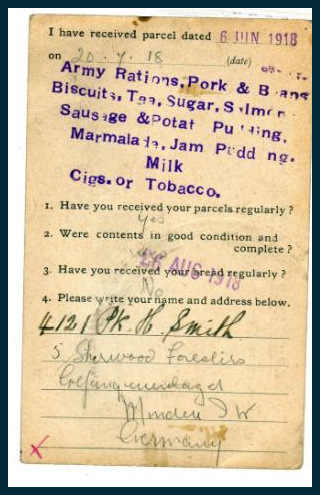
There are two long latrines in each block. They are of the trench type, lined with wood, open bar system, uncovered, no seats, emptied each day (according to the camp authorities). The men complained that the trenches were not emptied oftener than once a week, and that the odor from them was objectionable. A long urinal, approximately 100 feet in length, of the open trough type of wood, was attached to the wall in the open, without housing, was heavily incrusted with deposit and presented a strong odor and filthy appearance. In a barrack building in the middle of the block is a bath, equipped with 14 showers (hot and cold water); a dressing room adjoins the bath room. This building was found to be in a clean and orderly condition. In another building in the centre of the square sufficient facilities for washing and hand laundry are supplied by three long oblong tubs, each furnished with twenty seven spigots. This room was kept clean and orderly.
The kitchen is housed in a large barrack building in the outside group of each block. It is clean, orderly and in good condition. Each kitchen is equipped with seventeen kettles and two ranges. Two British prisoners of war are employed in each kitchen. These men stated that the raw food stuffs supplied to the kitchen were of good quality. The midday meal on the day of inspection … consisted of meat, sauerkraut and potatoes. It was very thin in potatoes and meat. The sauerkraut was of fair quality and of normal taste. The bread is the regular Kriegs-
The canteen is housed in the kitchen building. Wine, alcohol-
The infirmary, fifty by thirty five feet, with eight windows, in which fifteen cot beds were placed, was inspected in Block V. Complaints were registered in both Blocks I and V, that men were punished by confinement in Straf-
Private B stated that he was working in a camp at Bockhurst, that he was ill with rheumatism, but the guard would not permit him to see a doctor. He was returned to this camp (Minden) and placed in the jail barrack for fourteen days. At the end of two days of this sentence he was so ill that he had to be taken out of the prison dark cell by order of the camp doctor and sent to the hospital.
Packages and letters come irregularly. Two British were employed in the post office and two in the parcel post. The men were compelled to do the necessary camp work. All the British had sufficient good clothes and shoes. There is no library in this camp.
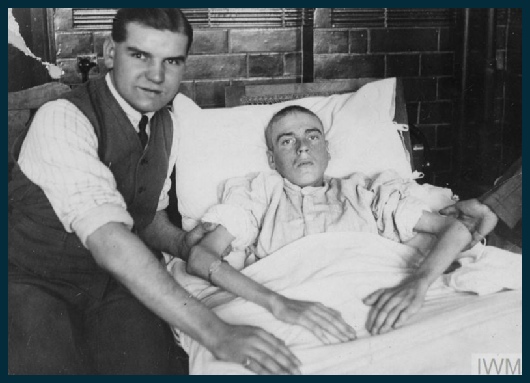
It was in this hell-
This photo does not show Wallace , but Private Thompson of the Durham Light Infantry, who was repatriated from a Prisoner of War camp at the end of the war shown in bed with two medical orderlies holding up his emaciated arms. Presumably Wallace was ina similarly poor condition when he too was repatriated after the Armistice.
Certainly it is an indication of his physical condition that he did not arrive in England until December 8th and was taken straight to Huddersfield War Hospital where he died of pulmonary tuberculosis on 21st December 1918.
The Malton Messenger of 28th December 1918 reported “The funeral of G. Wallace Piercy at Malton, of 15 Battalion (Leeds Pals) West Yorkshire Regiment and 19 years old. He was taken prisoner 15th April last. He arrived in England 8th of this month and died in Huddersfield War Hospital Saturday last (21st). Previous to joining the army he was a pupil teacher in the Wesleyan Day School and was an old boy of Malton Grammar School and took great interest in the work of the Wesleyan church. He was greatly loved and respected as evidenced by the numbers at his funeral”
Wallace was buried in New Malton cemetery. His parents are also commemorated on his monument there. He is commemorated on the Town memorial and also on War memorials in St Michael’s Church, Saville Street Methodist Church and Malton School.
